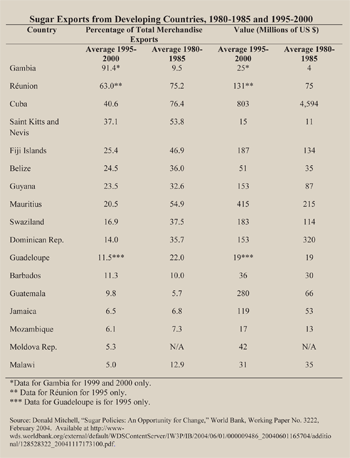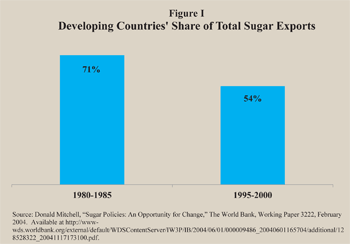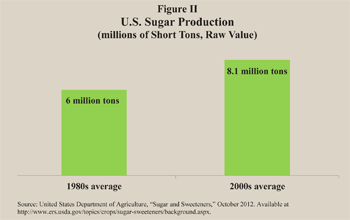Proponents of agricultural subsidies often justify them as necessary to compete in international agricultural markets and ensure a variety of plentiful, inexpensive food for domestic consumers. The federal government offers a wide range of aid to farmers, including: price supports and price floor programs; crop insurance — against both lost crops and lower than expected prices; government purchases of excess food stocks; and promotion of domestic crops through international trade agreements.
These agricultural subsidies distort trade, which adversely affects poor farmers and environmental protection in developing countries. Subsidies also impose a fiscal burden on taxpayers. Conversely, reducing agricultural subsidies in the United States (and other developed countries) could help poor farmers in developing countries compete in the marketplace, reduce ecosystem degradation and help reduce federal spending.
Domestic Impact of U.S. Agricultural Subsidies. Congressional debate over a new five-year farm bill is once again leading to questions about the effectiveness of government assistance to the agricultural sector. The 2008 farm bill continued a program that makes direct payments to farmers for certain crops based on the farmers’ historical acreage or yield, while ignoring current prices or production. Direct payments have become increasingly controversial, because they tend to benefit large farms instead of smaller family farms. Thus, a proposed farm bill passed by the U.S. Senate in May 2013 would eliminate direct payments to farmers. But billions of dollars would continue to flow from other subsidy programs. The projected cost of the Senate proposal is $955 billion over 10 years,1 a significant increase from the 2008 farm bill, which was expected to spend $604 billion over 10 years.2 For instance, under the Senate farm bill:3
- Crop insurance subsidies would cost more than $84 billion.
- Commodity programs, including farm loan subsidies and disaster assistance, would cost more than $41 billion.
- Conservation programs to help farmers protect against soil erosion, grow on less land and use ecologically friendly methods would cost more than $58 billion.
Several programs under the 2008 farm bill protect farmers from marketplace price fluctuations. In 2012 alone, the U.S. government spent an estimated $3.2 billion on dairy subsidies.4 For instance, under the Dairy Product Price Support Program, the U.S. Department of Agriculture (USDA) will purchase dairy products to prevent a drop in prices. Similarly, the Milk Income Loss Contract Program compensates dairy producers when milk prices fall below a specified threshold. In addition, the Dairy Export Incentive Program directly assists dairy exporters with cash bonuses when prices for U.S. products are not competitive overseas.

Harm to the Poor in Developing Countries. Subsidies lead to overproduction of certain crops in developed countries, causing prices to fall, sometimes below the cost of production. Oxfam International notes that the more than 10 million people in Central and Western Africa countries who rely on the production and sale of cotton lose up to $250 million every year due to subsidies. According to the Congressional Research Service, the United States spent about $24 billion on cotton subsidies over the past 10 years. In response to U.S. subsidies, Brazil filed a complaint in 2003 with the World Trade Organization (WTO) Dispute Settlement Body, alleging the United States did not comply with its commitments as a WTO member. In 2005, the WTO ruled that U.S. cotton subsidies are illegal.5 Yet the United States continues to violate its WTO commitments, seven years after that ruling.
Subsidies also invite retaliation under WTO rules. In 2009, a WTO arbitration panel granted Brazil the authority to collect $147.3 million damages, to impose punitive tariffs, and to lift patent protections on $829 million worth of United States goods.6
Sugar, another heavily subsidized crop, is grown in both developed and developing countries. According to the World Bank, over the 1999 to 2001 period, aid to sugar producers in developed countries belonging to the Organization for Economic Co-operation and Development (OECD) averaged $6.35 billion, while the total value of developing countries’ sugar exports averaged $6.5 billion annually.7 Thus, the World Bank found [see the table]:
- Over the 1980 to 1985 period, sugar accounted for 20 percent or more of total exports from 10 developing countries, and sugar represented 5 percent to 20 percent of total export earnings for nine other countries.
- However, over the 1995 to 2000 period, 12 countries received 10 percent or more of their total export earnings from sugar alone, while an additional five countries received 5 percent to 10 percent of total export earnings from sugar.
- Thus, developing countries’ share of total sugar exports declined from 71 percent over the 1980 to 1985 period to 54 percent from 1995 to 2000. [See Figure I.]

These price-distorting sugar subsidies also violate WTO standards.
Environmental Harm. Overproduction caused by subsidies also results in unintended environmental harms. In pursuit of subsidies, farmers often cultivate marginal farmland, where the thin soil is unable to replace depleted nutrients. For example, in the 1980s, rice export subsidies in many countries led to overproduction, and rice prices fell sharply. According to a report by the World Resources Institute, Thailand, one of the world’s largest rice exporters, then attempted to diversify its crops.8 Thailand also began to tax rice production, and the production of cassava for European markets grew instead. Thailand increased the acreage devoted to cassava by 50 percent, mainly in hillside tropical forests unsuitable for rice paddies.9
Farm subsidy opponents have also criticized the overuse of fertilizers and pesticides to farm fertile croplands more intensely and to bring marginal farmland into production. In the United States, excessive use of fertilizers and pesticides has led to concerns about environmental degradation in Florida’s Everglades. Studies have found that phosphorus in fertilizers used by sugar farmers has contaminated the Everglades water system.
A U.S. Department of the Interior report found that U.S. sugar cane price supports and import restrictions raised prices, leading to the planting of even more cane and beet acreage.10 The report asserts that planting additional acreage led to greater pressure for drainage and flood control in the Everglades. Furthermore, the report claims that because most of Florida’s sugar cane is grown in the Everglades Agricultural Area just south of Lake Okeechobee, the expansion of sugar cane acreage increased contamination, impairing water quality in the lake and nearby water conservation areas. According to the report, Florida sugar harvests grew from 233,000 acres in the early 1970s to 346,000 acres in the early 1980s, and up to 420,000 acres in 1990. Sugar cane production in the United States has grown since then. According to the USDA, U.S. sugar production expanded from an early 1980s average of six million short tons, raw value (STRV), to an average 8.1 million STRV in the 2000s.11 [See Figure II.]

Subsidy programs have encouraged large-scale sugar cane production in the Everglades, even though the land is not ideal.
Conclusion. Agricultural subsidies distort market prices and interfere with trade, causing deleterious distortions that adversely affect poor famers in developing countries and burden U.S. taxpayers. Moreover, in some cases agricultural subsidies can lead to environmental degradation. Reducing agricultural subsidies has the potential to help developing countries, the environment and taxpayers.
Marcelo Ostria is a research associate with the National Center for Policy Analysis.
Endnotes
1. Ralph Chite, “The 2013 Farm Bill: A Comparison of the Senate-Reported Bill (S. 954) and House-Reported Bill (H.R. 1947) with Current Law,” Congressional Research Service, May 30, 2013. Available at http://www.fas.org/sgp/crs/misc/R43076.pdf.
2. Jim Monke and Renee Johnson, “Actual Farm Bill Spending and Cost Estimates,” Congressional Research Service, December 13, 2010. Available at http://www.nationalaglawcenter.org/assets/crs/R41195.pdf.
3. Ralph Chite, “The 2013 Farm Bill: A Comparison of the Senate-Reported Bill (S. 954) and House-Reported Bill (H.R. 1947) with Current Law.”
4. USDA, “Budget Summary and Annual Performance Plan,” Fiscal Year 2012.
5. Randy Schnepf, “Brazil’s WTO Case Against the U.S. Cotton Program,” Congressional Research Service, June 30, 2010. Available at http://www.nationalaglawcenter.org/assets/crs/RL32571.pdf.
6. Ibid.
7. Donald Mitchell, “Sugar Policies: An Opportunity for Change,” World Bank, Working Paper No. 3222, February 2004. Available at http://www-wds.worldbank.org/external/default/WDSContentServer/IW3P/IB/2004/06/01/000009486_20040601165704/additional/128528322_20041117173100.pdf.
8. World Resources Institute, An Assessment of the Resource Base that Supports the Global Economy 1988 (New York City: Basic Books, 1988).
9. Ibid.
10. “Florida Everglades,” The Impact of Federal Programs on Wetlands: A Report to Congress by the Secretary of the Interior, Vol. 2, U.S. Department of the Interior, March 1994, Chapter VII; available at http://www.doi.gov/pmb/oepc/wetlands2/v2ch7.cfm.
11. U.S. Department of Agriculture, “Sugar and Sweeteners,” October 2012. Available at http://www.ers.usda.gov/topics/crops/sugar-sweeteners/background.aspx.